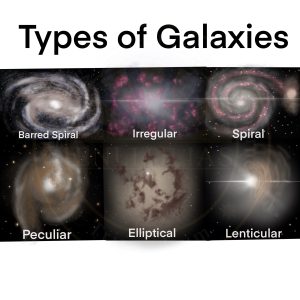What is it?
- A galaxy is a sprawling space system which is composed of stars, dust, interstellar gas, stellar remnants, and dark matter and all held together by gravity.
Types of Galaxy
- Spiral Galaxy
- The most common type of galaxy found throughout the universe is the spiral galaxy. Around 77% of the galaxies observed by man are spiral galaxies.
- Around two-thirds of all spiral galaxies have a bar-like structure – thus they are classified as barred spiral galaxies.
- They have a flat, spinning disk with a central bulge surrounded by spiral arms.
- The bulge located in the centre is made up of older, dimmer stars, and is thought to usually contain a supermassive black hole.
- For Example – Milky Way Galaxy
- The Milky Way galaxy hosts our solar system.
- It is shaped like a flat disc with a central bulge.
- The Milky Way is estimated to contain 100-400 billion stars.
- The inner stars travel faster than those further out. A supermassive black hole called Sagittarius A* is at the centre.
- The Solar System is located in the Orion Arm of the Milky Way.
- Stars like the Sun are rare in the Milky Way galaxy, whereas substantially dimmer and cooler stars, known as red dwarfs, are common.
- Andromeda is the closest big galaxy to the Milky Way
- Elliptical Galaxies
- Elliptical galaxies have an elongated spherical shape and lack a nucleus or bulge at the centre.
- Their light is dominated by older reddish stars.
- The stars, gases and other materials are spread throughout an elliptical galaxy.
- Elliptical galaxies usually consist of very old stars or stars with low masses.
- For example – PGC 1000714
- Irregular Galaxies
- Irregular galaxies have no definite shape, though they are in constant motion like all other galaxies.
- They don’t seem to possess a nuclear bulge or traces of spiral arms.
- Some irregular galaxies were once spiral or elliptical galaxies but were deformed by an uneven external gravitational force.
- Irregular galaxies are commonly small, and collectively they make up about a quarter of all the galaxies.
- The oldest and farthest galaxy ever discovered is an irregular type of galaxy called GN-z11.
- Lenticular Galaxies
- They appear like cosmic pancakes, fairly flat and featureless in the night sky. These galaxies can be thought of as the “in between” of spiral and elliptical galaxies.

